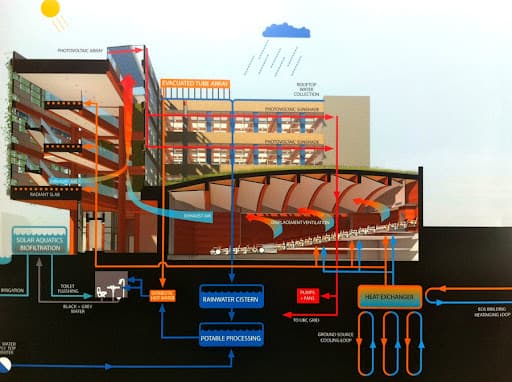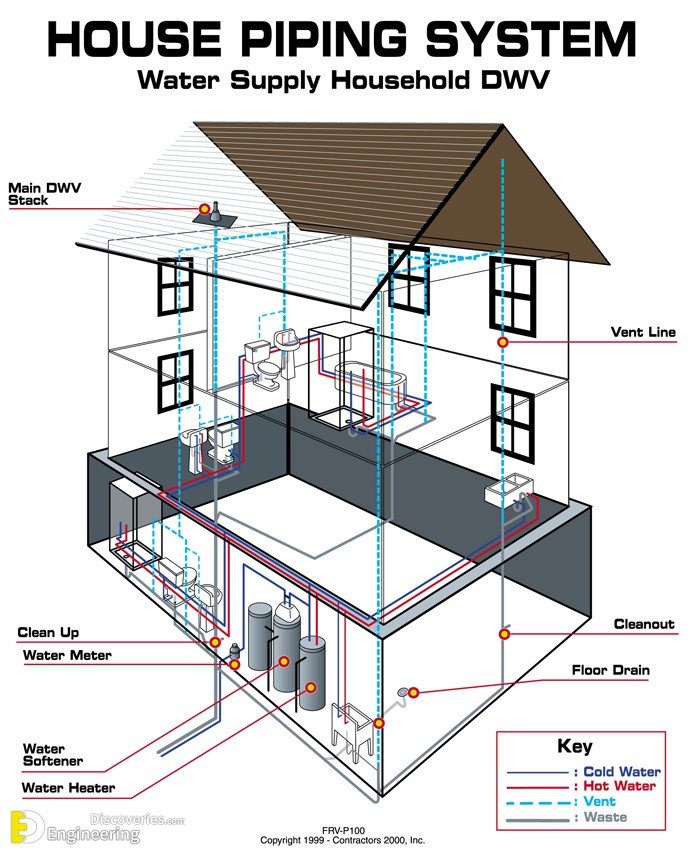The Basics to Your Home's Plumbing System Anatomy
The Basics to Your Home's Plumbing System Anatomy
Blog Article
We have discovered this post involving The Inner Workings of Your Home's Plumbing directly below on the internet and concluded it made good sense to talk about it with you on my blog.

Understanding exactly how your home's pipes system functions is vital for each property owner. From delivering clean water for alcohol consumption, cooking, and bathing to securely removing wastewater, a well-kept pipes system is critical for your family's health and wellness and convenience. In this thorough overview, we'll discover the detailed network that comprises your home's pipes and offer ideas on upkeep, upgrades, and handling typical concerns.
Intro
Your home's plumbing system is greater than just a network of pipes; it's a complex system that ensures you have access to tidy water and efficient wastewater removal. Knowing its components and how they collaborate can assist you stop costly repair services and make certain everything runs efficiently.
Standard Elements of a Pipes System
Pipes and Tubing
At the heart of your plumbing system are the pipes and tubing that lug water throughout your home. These can be constructed from numerous products such as copper, PVC, or PEX, each with its benefits in terms of toughness and cost-effectiveness.
Components: Sinks, Toilets, Showers, and so on.
Components like sinks, bathrooms, showers, and tubs are where water is utilized in your home. Recognizing just how these components attach to the pipes system assists in diagnosing problems and preparing upgrades.
Shutoffs and Shut-off Factors
Shutoffs manage the circulation of water in your pipes system. Shut-off valves are essential during emergencies or when you require to make repair work, permitting you to isolate parts of the system without disrupting water circulation to the whole home.
Water System System
Main Water Line
The main water line links your home to the community water supply or a private well. It's where water enters your home and is dispersed to numerous fixtures.
Water Meter and Pressure Regulatory Authority
The water meter measures your water use, while a pressure regulator makes certain that water moves at a risk-free pressure throughout your home's pipes system, preventing damages to pipes and fixtures.
Cold Water vs. Hot Water Lines
Understanding the difference in between cold water lines, which provide water straight from the main, and hot water lines, which carry warmed water from the water heater, helps in repairing and preparing for upgrades.
Drainage System
Drain Pipes Water Lines and Traps
Drain pipes lug wastewater away from sinks, showers, and bathrooms to the sewer or septic system. Traps protect against drain gases from entering your home and also catch particles that could create clogs.
Air flow Pipes
Air flow pipes permit air right into the drainage system, protecting against suction that might reduce drain and create traps to empty. Appropriate ventilation is necessary for maintaining the honesty of your plumbing system.
Value of Proper Water Drainage
Guaranteeing correct drain protects against backups and water damages. Routinely cleaning drains pipes and maintaining traps can prevent expensive repair services and extend the life of your plumbing system.
Water Heating Unit
Sorts Of Hot Water Heater
Hot water heater can be tankless or conventional tank-style. Tankless heaters warmth water on demand, while storage tanks store warmed water for immediate usage.
Updating Your Plumbing System
Reasons for Updating
Upgrading to water-efficient fixtures or changing old pipelines can enhance water top quality, reduce water costs, and increase the worth of your home.
Modern Pipes Technologies and Their Benefits
Check out technologies like wise leakage detectors, water-saving commodes, and energy-efficient water heaters that can save money and minimize ecological impact.
Expense Factors To Consider and ROI
Compute the ahead of time costs versus long-term cost savings when considering plumbing upgrades. Many upgrades pay for themselves with minimized energy expenses and less repairs.
How Water Heaters Link to the Plumbing System
Comprehending exactly how water heaters link to both the cold water supply and warm water circulation lines aids in detecting concerns like not enough warm water or leakages.
Upkeep Tips for Water Heaters
Frequently flushing your water heater to remove sediment, examining the temperature level settings, and examining for leaks can extend its lifespan and boost power performance.
Typical Pipes Concerns
Leakages and Their Reasons
Leaks can occur due to maturing pipelines, loose installations, or high water pressure. Dealing with leakages without delay stops water damage and mold development.
Obstructions and Clogs
Blockages in drains and toilets are often triggered by purging non-flushable items or a build-up of grease and hair. Utilizing drainpipe screens and being mindful of what drops your drains can avoid blockages.
Signs of Pipes Troubles to Look For
Low water stress, slow-moving drains, foul odors, or unusually high water costs are indications of prospective plumbing troubles that should be resolved immediately.
Plumbing Upkeep Tips
Normal Assessments and Checks
Schedule yearly plumbing examinations to capture issues early. Look for indicators of leaks, deterioration, or mineral accumulation in taps and showerheads.
DIY Maintenance Tasks
Basic tasks like cleansing faucet aerators, looking for bathroom leakages utilizing color tablets, or insulating revealed pipes in cool climates can stop major pipes issues.
When to Call a Specialist Plumbing Technician
Know when a plumbing problem calls for expert competence. Attempting complicated repair work without proper expertise can bring about more damages and higher fixing expenses.
Tips for Lowering Water Use
Simple practices like dealing with leaks immediately, taking much shorter showers, and running full tons of washing and recipes can conserve water and lower your energy bills.
Eco-Friendly Plumbing Options
Think about lasting pipes materials like bamboo for flooring, which is durable and environment-friendly, or recycled glass for kitchen counters.
Emergency situation Readiness
Steps to Take During a Plumbing Emergency situation
Know where your shut-off shutoffs lie and just how to shut off the water system in case of a ruptured pipeline or significant leak.
Significance of Having Emergency Get In Touches With Convenient
Keep contact info for regional plumbing professionals or emergency services easily available for quick action throughout a plumbing dilemma.
Ecological Effect and Preservation
Water-Saving Components and Home Appliances
Mounting low-flow faucets, showerheads, and bathrooms can dramatically minimize water usage without compromising efficiency.
Do It Yourself Emergency Fixes (When Relevant).
Temporary fixes like using air duct tape to spot a dripping pipeline or putting a container under a leaking faucet can reduce damages up until an expert plumbing technician shows up.
Final thought.
Comprehending the composition of your home's plumbing system equips you to preserve it effectively, saving money and time on fixings. By adhering to routine maintenance routines and staying informed concerning modern-day pipes innovations, you can ensure your pipes system operates efficiently for several years ahead.
Exploring Your Homes Plumbing Anatomy
Water Supply System
Main Water Line: This is where water enters your home from the municipal supply or a private well. Water Meter: Typically located near where the main water line enters the property, it measures the amount of water used. Shutoff Valve: It s crucial to know where this is in case of emergencies. It allows you to turn off the water supply to the entire house. Pipes and Fittings: These distribute water throughout your home. Materials can include copper, PVC, or PEX. Drain-Waste-Vent (DWV) System
Drains: Located in sinks, showers, and tubs, these carry wastewater away. Traps: U-shaped pipes under sinks that hold standing water, blocking sewer gases from entering the home. Vents: Pipes that lead from the DWV system to the outside, preventing vacuum formation and allowing gases to escape. Sewer Line: Carries all wastewater from the home to the municipal sewer system or a septic tank. Fixtures and Appliances
Sinks, Toilets, and Showers Dishwashers and Washing Machines Water Heaters Maintenance Tips
Regularly check for leaks in exposed pipes and around fixtures. Inspect the water heater annually for signs of wear. Clean drains and traps to prevent clogs and odors. Know how to shut off water to individual fixtures. When to Call a Professional
Major leaks or burst pipes Installation of new pipes or fixtures Septic tank issues Remodeling projects that involve plumbing changes Conclusion
Understanding the anatomy of your home's plumbing is key to maintaining a functional and efficient system. Regular checks and knowing when to call in the experts can save you time, money, and stress.
https://www.mavyn.com/blog/exploring-your-homes-plumbing-anatomy

Hopefully you liked our excerpt about Plumbing Installation 101: All You Need to Know. Thanks a ton for finding the time to read through our short article. Sharing is nice. You won't know, you may just be helping someone out. Thank you so much for taking the time to read it.
Book A Service Call Report this page